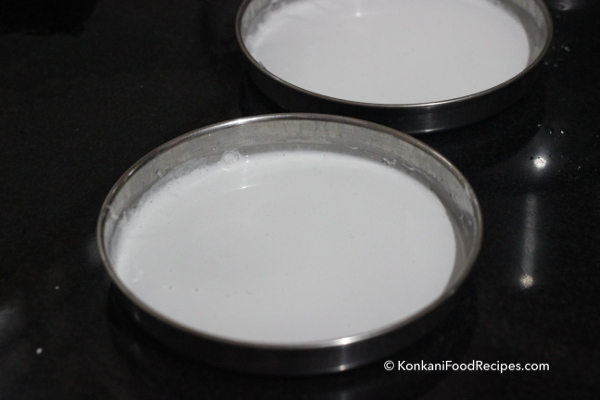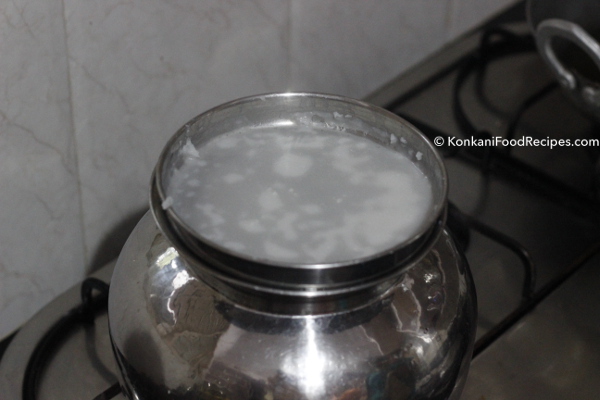Udupi Cuisine's Rice Crepes Recipe (Dodna, Sameerpan)

While it is raining heavily outside, one of the best things to enjoy is some steamed, hot rice crepes with coconut oil on top.
These silky smooth, papery thin steamed rice crepes are a good old tea time snack. These rice crepes are called sameerpan in Konkani and dodna in Kannada. Ever had them?
Until I was 12 we stayed as a joint family. A big fat family of 40 people back then, in our ancestral house. (Our number is now up to 62.) My mom and granny would make a wood fire outside the kitchen and would steam these rice crepes on boiling water like in the pics below. Steamed paper thin rice crepes would then be removed from the plate they were steamed in and would be served steaming hot. These crepes are had with just coconut oil on top and are bland for the most part. But trust me they are to die for. 😍 We would take turns and sit beside my mom/granny, eat tummy full of crepes. To feed all of us at home, they had to steam these crepes for 1-2 hours. Poor guys. But they did it with such pleasure. 😘 They are the most sought after tea time snacks. These days they are steamed on the stove top, but one thing that hasn't changed is we still have about 25 paper thin crepes in one shot. 😀
Rice is ground into a fine paste and is then made into a watery batter using salt. A thin layer of this batter is smeared onto a plate and is then steamed on boiling water. These paper thin crepes are then removed from the plate and are served. Or they are sun dried to make rice papads (akki happala in Kannada, tandla hapolu in Konkani). Rice papads are then stored for year long's use & are deep fried as a evening snack or are served for lunch/dinner.
If your memories are rekindled and you ever wanna try making these rice crepes at home. Here's how to:
Ingredients:
- 3/4 cup rice (any medium grained rice should do)
- Salt to taste
- 1 cup water
Preparation Method:
Preparing the batter:
1. Grind rice into a smooth paste using as much water as required. A wet grinder gives you a smoother batter than a mixer does.
2. Transfer the ground batter into a cooking vessel. Add salt & mix well.
3. We need the batter to be of semi-thick consistency. Not too thick nor too watery like that of neer dosa.
Steaming the crepes:
P.S: Traditionally they are steamed in the way you see in the pics below. But you can use a saucepan with a lid or a cooking vessel with a lid of any frying pan & use plates with edges to steam the crepes in. Here's a video to give you an idea.
1. Get a saucepan/cooking vessel filled with water up until 3/4th it's volume. Bring it to a rolling boil.
Transfer a ladle of batter onto a plate which has edges. Shake the plate to spread the batter all across the plate. We need a thin layer of batter. Not too thick nor too thin to enjoy the perfect crepes.
P.S: The plate you use has to fit the saucepan perfectly. It has to sit on top of your vessel without leaving any gap in between.
2. Once the water has come to a boil, keep the plate on top of the vessel. Close it using a lid.
3. The water in the vessel will cook the crepes. The lid used should fit the plate perfectly so that the steam gets trapped in & cooks the crepes perfectly.
4. Once the crepes are fully cooked, the colour changes completely, remove the plate with batter out.
5. Using a knife tip try to remove the crepe from the plate.
6. Add a teaspoon of oil on top of the crepe & enjoy them hot.
Most important:
1. Perfectly cooked crepes are the key to enjoying some delicious rice crepes. To be cooked perfectly there shouldn't be any steam escaping from the vessel on keeping the plate or from the closed lid.
2. If the water in the vessel reduces with time, do fill it with water & wait until it comes to a rolling boil.
3. A perfectly smooth batter will you give you silky smooth crepes.
4. A thin layer of batter on the plate is the key to getting perfect crepes. If the batter applied is thin, it'll break off. If it's thick, the crepe won't be a pleasure to eat.






Tweet